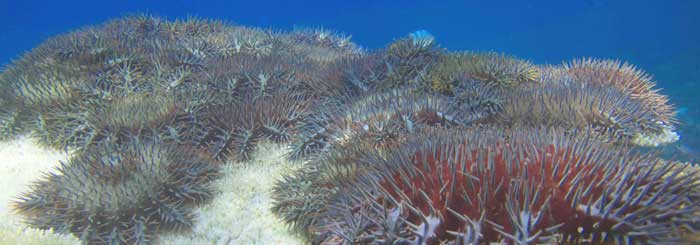Often referred to by its abbreviation COTS, the Crown of Thorns Starfish is responsible for approximately 42 percent of the coral loss on Australia’s Great Barrier Reef.
In fact, outbreaks of this marine pest are causing damage to coral reefs all around the world. The Atlantic Ocean is the only area yet to record outbreak sightings.
At a local level in North Queensland, this coral-eating starfish poses not only an economic threat to Australia’s tourism and fishing industries, but also to the World Heritage-listed Great Barrier Reef itself.
Since Crown of Thorns Starfish is one of the main threats to the future of the Great Barrier Reef we wanted to find out more.
Australia is at the forefront of both research and management of COTS and we were able to meet up with two local experts – Col McKenzie from the Association of Marine Park Tourism Operators (AMPTO) and Sheriden Morris from the Reef and Rainforest Research Centre (RRRC).
[headline size=”small” align=”left”]12 interesting facts about crown of thorns starfish[/headline]
- Fossil evidence suggests COTS have been around for millions of years although outbreaks have only been observed in the last 50 or so years.
- COTS are a natural part of the ecosystem and an over-abundance only occurs when the reef is out of balance and unhealthy.
- In healthy reef conditions COTS can play a productive role by eating some of the faster-growing corals and giving the slower-growing corals a chance to catch up and regenerate.
- The first recorded outbreak of COTS was in the Ryukyu Islands off Japan in the 1950s
- The first COTS outbreak in Australia was recorded in 1962 at Green Island. There has now been between 3-4 recorded outbreaks in Australia.
- The Crown of Thorns has only a few predators, which include triton’s trumpet, the white spotted puffer fish, the lined worm, the harlequin shrimp and two species of triggerfish (yellowmargin triggerfish and titan triggerfish). The red emperor, spangled emperor and parrotfish are also known to eat juvenile COTS before the starfish grow their spikes.

- COTS spawn on the Great Barrier Reef between October-March when water temperatures are at their highest. Female COTS release eggs into the water and nearby males release sperm, which then fertilise the eggs. Large female COTS can produce up to 65 million eggs per season.
- COTS start off as planktonic larval and drift along on top of the water for weeks before settling at the bottom of the ocean floor. They are most vulnerable to predators as juveniles before their spiky spines have grown. At about one year of age they develop spines and begin to feed on coral.
- Adult COTS can grow up to a metre in diameter and have up to 21 arms. If they shed an arm due to stress or injury they regrow within six months.
- COTS spines are long and sharp and covered with an epidermis containing the venom ‘plancitoxin’. They are toxic to both marine life and humans.
- COTS eat by everting their stomach through their mouth and then spreading it out over the surface of the coral using their tube feet. They then digest their food externally.
- Adult COTS almost exclusively eat scleractinian. They can survive without feeding for up to nine months.
[headline size=”small” align=”left”]Crown of thorns starfish and the great barrier reef[/headline]
COTS outbreaks are a threat to the future of the Great Barrier Reef because they are happening more regularly and there is not enough time between outbreaks for coral to regenerate.
An average of 15 years between outbreaks is sustainable but with other environmental factors also causing damage such as cyclones and coral bleaching, it puts the Reef at great risk.
Research suggests that the increasing COTS outbreaks are caused by several contributing factors. These include excessive nutrients in the water as a result of fertilisers and sewage running off the land and overfishing which reduces the number of their natural predators.
[headline size=”small” align=”left”]Controlling crown of thorns starfish outbreaks[/headline]
 The AMPTO instigated a COTS Targeted Control Program in 2012 to protect dive sites. A team of 22 divers work all year round to kill off COTS in these areas by injecting them with bile salts.
The AMPTO instigated a COTS Targeted Control Program in 2012 to protect dive sites. A team of 22 divers work all year round to kill off COTS in these areas by injecting them with bile salts.
While this approach may work for minimising the damage on dive sites that are important for the tourism operators, it is obviously not feasible for larger areas (and, let’s not forget, the Great Barrier Reef stretches for over 2300 kilometres).
The Reef and Rainforest Research Centre (RRRC) is taking a more holistic view and looking into ways to treat Crown of Thorns Starfish outbreaks in the same way that pests are treated in agriculture.
Thanks to AMPTO for some of these images



